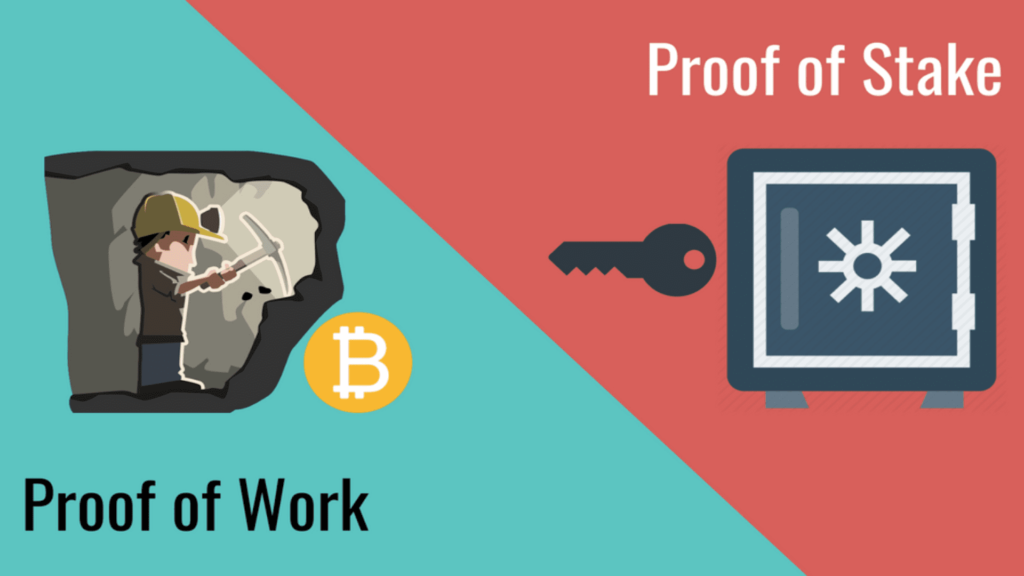Nowadays, Proof of Work and Proof of Stake are the two most widely used algorithms for blockchain consensus. These two methods play an essential role in blockchains: determining who will and will not be able to add a new block.
The Blockchain system
It’s all in the name: blockchains are made out of blocks. By respecting a strict protocol, these blocks record information and every transaction happening on a network. The consensus algorithm (Proof of Work, Proof of Stake, or other) will then determine who can build a block, and network nodes will assess whether a block complies with the protocol (the rules).
This technology is decentralized and does not need any intermediaries. Information is detained by the numerous participants of the blockchain, as opposed to a single entity as has traditionally been the case.
What is Proof of Work (PoW)?
Used today by Bitcoin and Ethereum, Proof of Work was the first consensus algorithm to be used in blockchains. In order to create new blocks, participants of a network (aka miners) provide their computational capacity to solve complex mathematical problems. As time goes on, problems grow more and more complex, and more energy will therefore be needed to solve them. A block is added to the blockchain when the result of the mining process is verified and adopted by the network. In this case, the miner in question receives a “block reward”: cryptocurrency (e.g. Bitcoin), as well as transaction fees as compensation for their work.

What is Proof of Stake (PoS)?
Instead of using computational power to participate in the effort to secure the blockchain, Proof of Stake consensus algorithm secures the network by putting a number of tokens or coins at stake. In order to forge a block and add it to the blockchain, users have to unlock some of their coins. They will then be selected according to several criteria: number of coins at stake, date at which they were, or even randomly. Just like PoW miners, PoS “forgers” receive a reward in the form of cryptocurrency (Bitcoin, Ethereum…).
In order to discourage dishonest validators, a sanction mechanism called “Slashing” was thought up. Validators who do not obey the rules of a network can have their number of tokens reduced. Worse still, they could be temporarily or permanently banned. Nevertheless, this system is not used by all blockchains: it is notably the case for Cardano which is based on a unique reward-sharing system.

Pros and cons of these two algorithms
The pros of one algorithm are the cons of the other. An important difference between the two models is that while Proof of Work demands lots of resources (electricity, energy) due to an ever more difficult mining process, Proof of Stake algorithm is a lot less energy-intensive.
Blockchain security is another major point of focus, and Proof of Work is ahead in this area. Indeed, it would take an attack strength of at least 51% of the total power of the blockchain to hack a Proof of Work network, and even then, it would be possible to gather an even greater power to counter it. In the case of Proof of Stake, this solution is not on the table. All it would take is for a malicious entity (which could be a group of users) to possess 51% of emitted tokens for it to become virtually untouchable. All remaining solutions would unfortunately be destructive.
Moreover, both algorithms share a centralization problem:
- Proof of Work: with mathematical problems becoming more and more complex, we have seen the emergence of gigantic mining pools (groups of miners) which possess an important part of the network’s total power.
- Proof of Stake: as explained earlier, in order to forge a PoS block, one needs to pass a token threshold. If this threshold is too high, notably in terms of price (e.g. Ethereum threshold is 32= ~$60,000), only a few individuals or pools (groups of forgers) will be able to build blocks.
One thing to keep in mind is that the Proof of Stake algorithm is more recent than its counterpart, and aims at correcting some of the flaws of the Proof of Work consensus. A notable difference is that Proof of Stake offers better scalability (capacity of a network to adapt to a higher interaction amount) and significantly faster transactions, for a lower cost.

Summary table
| Proof of Work (PoW) | Proof of Stake (PoS) |
| High energy cost | Low energy cost |
| Centralization risk | Centralization risk |
| High security | Relatively lower security |
| Slow, costly transactions | Fast, cheap transactions |
Sources:
- https://akeo.tech/blog/blockchain-and-dlt/proof-of-work-vs-proof-of-stake-a-perfect-guide-for-beginners-2/
- https://www.crypto-sous.fr/blockchain-fonctionnement/proof-of-work/
- https://cryptoadventure.org/beginners-guide-to-the-proof-of-stake-consensus-mechanism/
- https://coinmarketcap.com/alexandria/article/proof-of-work-vs-proof-of-stake
